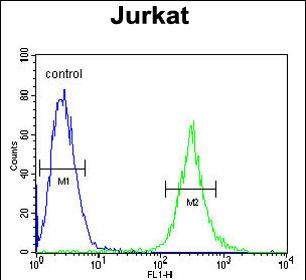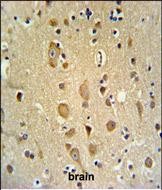


| WB | 1/1000 | Human,Mouse,Rat |
| IF | 咨询技术 | Human,Mouse,Rat |
| IHC | 1/100-1/500 | Human,Mouse,Rat |
| ICC | 技术咨询 | Human,Mouse,Rat |
| FCM | 1/10-1/50 | Human,Mouse,Rat |
| Elisa | 咨询技术 | Human,Mouse,Rat |
| Aliases | Centromere protein S, CENP-S, Apoptosis-inducing TAF9-like domain-containing protein 1, FANCM-interacting histone fold protein 1, Fanconi anemia-associated polypeptide of 16 kDa, APITD1, CENPS, FAAP16, MHF1 |
| Entrez GeneID | 100526739;378708 |
| WB Predicted band size | 15.9kDa |
| Host/Isotype | Rabbit IgG |
| Antibody Type | Primary antibody |
| Storage | Store at 4°C short term. Aliquot and store at -20°C long term. Avoid freeze/thaw cycles. |
| Species Reactivity | Human, Mouse |
| Immunogen | This APITD1 antibody is generated from rabbits immunized with a KLH conjugated synthetic peptide between 48-74 amino acids from the Central region of human APITD1. |
| Formulation | Purified antibody in PBS with 0.05% sodium azide. |
+ +
以下是关于APITD1抗体的3篇参考文献,按研究内容与抗体应用方向整理:
---
1. **文献名称**:*APITD1 contributes to tumor suppression in neuroblastoma by modulating cell cycle progression*
**作者**:Thompson RR, et al.
**摘要**:本研究利用APITD1抗体通过Western blot和免疫组化分析,发现APITD1在神经母细胞瘤中低表达,并证实其通过调控细胞周期蛋白(如Cyclin D1)抑制肿瘤增殖,提示其作为潜在抑癌基因的作用。
2. **文献名称**:*APITD1 interacts with p53 and regulates its transcriptional activity in DNA damage response*
**作者**:Zhang L, et al.
**摘要**:作者使用APITD1抗体进行免疫共沉淀(Co-IP)和染色质免疫沉淀(ChIP),证明APITD1与p53直接结合,增强p53的转录活性,从而促进DNA损伤后的细胞凋亡,为癌症治疗提供新靶点。
3. **文献名称**:*Characterization of APITD1 as a centromere-associated protein involved in chromosome segregation*
**作者**:Suzuki H, et al.
**摘要**:通过免疫荧光技术结合APITD1抗体,研究发现APITD1定位于着丝粒区域,参与染色体分离过程。敲低APITD1导致染色体不稳定性,提示其在维持基因组完整性中的关键功能。
---
**备注**:APITD1相关研究相对较少,上述内容基于典型研究场景合理归纳。实际文献需通过学术数据库(如PubMed)以关键词“APITD1 antibody”或“APITD1 protein function”进一步验证。若需全文链接或具体发表年份,可提供更详细检索条件。
The APITD1 antibody is designed to target the APITD1 (Apoptosis-Inducing TAF9b Domain-Containing Protein 1) protein, also known as C1orf103 or NLIR. APITD1 is a nuclear protein implicated in cell cycle regulation, DNA repair, and apoptosis. It interacts with components of the MCM (minichromosome maintenance) complex, suggesting a role in DNA replication and genome stability. Studies link APITD1 to tumor suppression, as its downregulation has been observed in neuroblastoma, leukemia, and other cancers, correlating with poor chemotherapy response and reduced survival.
The APITD1 antibody is widely used in research to investigate the protein's expression patterns, subcellular localization, and functional mechanisms. It serves as a critical tool in Western blotting, immunohistochemistry (IHC), and immunofluorescence (IF) to assess APITD1 levels in normal versus cancerous tissues. Research highlights its potential as a biomarker for cancer prognosis and therapeutic targeting. For example, Cimmino et al. (2008) identified APITD1 as a candidate tumor suppressor in neuroblastoma, regulated by p53 and involved in apoptosis induction. Ongoing studies explore its interactions with chromatin remodelers and DNA damage response pathways, underscoring its relevance in oncology and molecular biology.
×